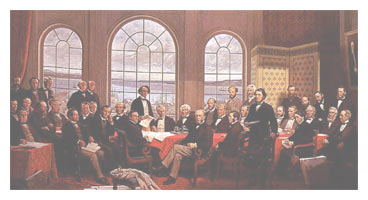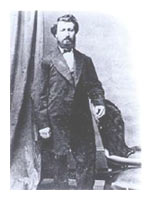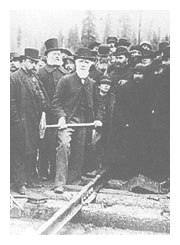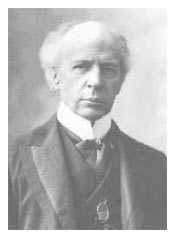 |
| Confederation |
The Confederation Idea
Sentiment bound the Canadas, the Maritimes, and British Columbia
more closely to England than to each other. There were different
standards of currency in use in the several colonies, and trade
between them was complicated by customs barriers. Their everyday
business brought them into close touch with the United States.
When the St. Lawrence ports of Quebec and Montreal were frozen
in, news and even passengers traveled on the new United States
railways across the eastern states from New York to the Canadian
border. The newly invented magnetic telegraph, which was installed
in Toronto in 1846, soon connected that city not only with Quebec
but also with New York City and New Orleans in the United States.
From 1861 to 1865 people in the British colonies watched with
interest and uneasiness the course of the American Civil War.
From this great conflict they saw arise a freshly united nation,
powerfully equipped with what were now surplus tools of war
and, in the opinion of many, only too willing to use them against
the neighboring colonies of Great Britain. Britain had almost
gone to war against the North because the North's blockade of
Southern shipping interfered with Britain's cotton trade.
The aborption of the British colonies into the United States
was again being called for by United States extremists who revived
the old cry of "manifest destiny" of their republic. Lord Elgin
had negotiated a ten-year trade treaty with the United States
whereby tariffs were reduced on a reciprocal basis on many items.
The resulting stimulation of trade was scheduled to cease in
1864, when United States renewal of the treaty was withheld.
The desirability of subtituting increased intercolonial trade
was recognized by everyone in Canada and the Maritimes. The
government of the Canadas under the Act of Union was running
into difficulties because Canada West by this time had increased
in population faster than Canada East. The act had provided
for equal representation of both parts of the colony at a time
when French-speaking Canada East was numerically much larger
than Canada West. A state of almost continuous deadlock ensued
in Parliament, with no government able to secure a clear majority.
Between 1861 and 1864 four separate ministries and two general
elections failed to end the impasse. In 1864 a coalition headed
by the leader of the Conservatives, John A. Macdonald, and Liberal
leader George Brown, who was founder of the Toronto Globe, gave
promise of a more stable government (see Macdonald).
Macdonald, with his trusted ally Georges-Etienne Cartier from
Canada East, then obtained Brown's assurance of cooperation
in the best interests of the country, even though Brown had
long considered Macdonald and Cartier his deadly political enemies.
The coalition government wanted to work out some form of federal
union to include the Maritime Provinces if they were willing.
Provincial matters would be left to the individual provinces.
Only subjects of concern to all the provinces would be dealt
with by the federal government.
Dominion from Sea to
Sea
By fortunate coincidence, the possibility of a local union of
colonies was under discussion at this very time in the Maritimes.
A conference was convened in Charlottetown, P.E.I., in 1864
to discuss the question. Macdonald, accompanied by Brown and
Cartier, headed a delegation from Canada to this meeting of
their Maritime cousins. They set forth the possible advantages
of a union wide enough to include the Canadas as well. It was
quickly agreed that another meeting should be held to consider
the plan further. The result was the Quebec Conference, which
was held later the same year. Agreements in principle on the
conditions that might permit so ambitious a union were finally
reached. These agreements were summed up in the Seventy-two
Resolutions. As if to lend emphasis to the importance of such
a union, the anti-British Fenians in the United States were
voicing plans to strike a blow for Irish independence at home
by invading the British colonies in North America. In 1866 this
threat culminated in a series of raids across the border into
Canada, which were successfully repulsed. The United States
took steps to preserve its neutrality by suppressing further
Fenian attacks from its side of the border. Some of the national
spirit of 1812 to 1814 was rekindled in the British colonies
and served to strengthen the movement toward confederation.
In 1866 representatives of New Brunswick, Nova Scotia, and the
Canadas came together in London for final discussions with the
Colonial Office. Newfoundland and Prince Edward Island for the
moment had withdrawn from the confederation talks. The London
Conference led directly to the most important statute in Canadian
constitutional history, the British North America Act of 1867.

1867, The birth of a new
country. |
This act, with its subequent amendments, embodied the written
constitution of Canada for more than a century. It was proclaimed
on July 1, now celebrated as Canada Day. The British North America
Act provided that there should be four provinces in the new
Dominion at the outset--Ontario, Quebec, New Brunswick, and
Nova Scotia--and that others could join later. Each province
was to have its own seat of government, its own lawmaking body,
and its own lieutenant governor to represent the Crown. In addition,
the act established a federal government at Ottawa, composed
of a House of Commons (elected), a Senate (appointed for life),
and a governor-general as the Crown's representative. It set
forth the matters on which the provinces could make laws and
listed those that were the special concern of the government
at Ottawa. Any powers not listed were to belong to the federal
government. (The act remained in force until the Constitution
Act of 1982.)
New Dominion Is Launched
The first Parliament of the new Dominion met on Nov. 6, 1867,
with Macdonald as prime minister. By the Deed of Surrender of
1869, Canada purchased the vast Northwest Territories from the
Hudson's Bay Company. The company was permitted to retain trading
rights in the area and a small percentage of the prairie lands.
The only western settlement of importance east of the Rockies
was the Red River colony in Manitoba, which had attained a population
of some 12,000 since Selkirk's time. The metis were the most
numerous of these settlers. Their leader, Louis Riel, defied
the new governor sent out to take over possession of the territory
from the Hudson's Bay Company.

Louis Riel |
Riel seized Fort Garry, set up his own provisional government,
and forwarded demands to Ottawa that the civil rights and the
land rights of the people be protected. At this point Riel might
easily have won a place in Canadian history as the father of
Manitoba, but he committed the grave error of imprisoning some
of the Ontario settlers who opposed him and of having one of
them, Thomas Scott, executed.
Calmer judgments prevailed when Donald Smith (later Lord Strathcona)
and Bishop Alexandre Tache, the religious leader of the Red
River Settlement, went to Ottawa and obtained passage of the
Manitoba Act of 1870. By this act Manitoba was constituted a
province, with its seat of government at Fort Garry (later Winnipeg).
But it was a much smaller province, amounting to little more
than the Red River Settlement. The right of the French-speaking
inhabitants to their own religion and schools was recognized.
Soldiers under Col. (later Sir) Garnet Wolseley were sent to
Fort Garry to bring law and order on authority from Ottawa.
Riel allowed his provisional government to collapse and fled
from the new province. The Red River Rebellion was ended but
not the career of Riel. The first Dominion census, which was
taken in 1871 in accordance with the British North America Act,
showed a population of 3,689,257.
In the same year the Treaty of Washington was signed between
Great Britain and the United States, which settled United States
and Canadian use of the Great Lakes-St. Lawrence system and
the Yukon River in Alaska. The United States was accorded fishing
rights in Canadian Atlantic waters for a limited period in return
for 5 1/2 million dollars in compensation. Among the five commissioners
who represented Great Britain in these negotiations was Macdonald.
His presence was a recognition of Canada's new status in the
British Empire.
During the same summer of 1871, British Columbia joined the
new Canada Confederation. Improvement in overland communications
was a primary condition imposed by the new province. Macdonald
pledged that the Dominion government would begin construction
of a transcontinental railway within two years and complete
it within ten years.
Progress on the Intercolonial Railway, which was to link the
Maritimes with Quebec, encouraged Prince Edward Island in 1873
to become the seventh province in the Dominion. The transcontinental
railway project already was requiring heavy financial commitments
by the government, and Macdonald was under considerable pressure
in the House of Commons as well as in the press. He won the
election of 1872, only to face charges by his political enemies
that railway contractors had contributed heavily to his party's
election funds. The Pacific Scandal, as this incident was named,
defeated the Conservatives in 1873.
Alexander Mackenzie headed the Liberal government that then
took office. Mackenzie's contribution to the infant Dominion
was real though unspectacular. During his term in office from
1873 to 1878, voting by ballot was introduced in 1874; the Supreme
Court of Canada held its first sitting in 1876; and the Intercolonial
Railway ran its first train from Halifax to Quebec, also in
1876. A tireless worker and a man of high personal integrity,
Mackenzie nevertheless did not have great popular appeal. When
Macdonald fought the 1878 election on a platform of protectionist
tariffs, which he called his National Policy, the voters favored
their "old chieftain." The Conservatives thus were returned
to office.
Macdonald's National
Policy
Macdonald sought to strengthen the new Dominion both at home
and abroad. He could foresee the ultimate evolution of something
akin to the modern British Commonwealth, in which Canada would
be an equal partner with the mother country.
During the seven years following his return to office, his government
adopted its previously announced protective tariff (1879), appointed
Canada's first high commissioner to London (1880), annexed the
Arctic Archipelago (1880), and completed the overdue transcontinental
railway (1885).
In 1885 word of a new crisis was flashed from the Northwest
Territories. Louis Riel was leading the metis of the valley
of the South Saskatchewan in a new uprising against the federal
government, and this time he had aroused numbers of the Indians
to fight beside him. A militia force was hastily dispatched
under Gen. Frederick Middleton over the completed portion of
the Canadian Pacific Railway. Within a few weeks the Northwest
Rebellion was put down and Riel was arrested. His trial for
treason and his execution aroused wide controversy across Canada
and to a considerable extent cost the Conservative party the
support of French-speaking Canadians for many decades.
Macdonald's National Policy was by now the chief target of the
Liberals, who were calling for "unrestricted reciprocity" in
trade with the United States. Macdonald won the 1891 election.
His health was failing, however, and later that year he died.

Completion of Trans-Canada
Railway |
Because of their government majority, the Conservatives were
not required to call a new election for five years. During this
time, however, they had to select four prime ministers in succession--Sir
John J.C. Abbott (1891-92), Sir John S.D. Thompson (1892-94),
Sir Mackenzie Bowell (1894-96), and Sir Charles Tupper (1896).
Finally the Conservative party foundered, under Tupper's leadership,
on the thorny Manitoba School Question. Manitoba had abolished
its separate Roman Catholic schools a few years earlier. This
was allegedly in violation of provisions in the Manitoba Act
and the British North America Act. The provincial government's
action was upheld, however, by the Judicial Committee of the
Privy Council. (See also Abbott; Thompson, John Sparrow David;
Tupper.) The new Liberal leader, Wilfrid Laurier, a French-speaking
Canadian, favored conciliation rather than coercion. The Conservatives
were defeated on the issue in the election; and the responsibility
of government passed to the Liberals, under Laurier.
The Age of Laurier
Wilfrid Laurier's regime lasted 15 years. It was one of renewed
growth and prosperity. The Manitoba School Question was promptly
hushed up by new legislation enacted by the province in accordance
with a compromise worked out with Ottawa. To his Cabinet Laurier
drew some of the most capable leaders from every part of Canada.
Business throughout the world was on an upswing, and the Laurier
government rode the crest. The demand for Canadian wheat abroad
encouraged immigration, and immigration in turn increased farm
production and the value of national exports. "The 20th century
belongs to Canada," cried Laurier; and the whole nation took
confidence from his assurance. Two new transcontinental railways
were begun. By 1905 the west had expanded in both population
and economic strength to such an extent that two new provinces,
Alberta and Saskatchewan, were carved out of the Northwest Territories.
These encouraging developments were inadvertently assisted by
an occurrence in the far northwest. Since the Fraser River gold
strike of 1858, prospectors had been consistently combing the
mountainous areas of British Columbia and to the north. In 1896
their persistence paid off with the discovery of gold nuggets
on the Klondike River in the far western Yukon Territory. When
the news spread, the gold rush of 1897 began; it was to become
the most publicized gold rush in history, eventually to be celebrated
in the works of such writers as Jack London and Robert Service.

Sir Wilfried Laurier |
The gold strike had some beneficial side effects. As miners
poured into western Canada from the United States and other
parts of the world, the extent of the unpopulated prairie lands
became known. By this time, of course, the supply of free land
in the United States had become exhausted, and the frontier
was closed. Very soon after the gold rush, settlers began pouring
into the western prairies of Canada by the thousands, from Europe
as well as the United States. They came from as far away as
Russia to establish farms on the open wheatlands. It was not
long before demands arose for the creation of at least one province
between Manitoba and British Columbia.
Thus, in 1905, the government in Ottawa formed two new provinces,
Alberta and Saskatchewan. Another benefit resulting, at least
in part, from the gold rush was the discovery of other minerals
in the Canadian wilds. As early as 1883, nickel had been found
at Sudbury, Ont. In the early 1890s large deposits of base-metal
ores were found in southern British Columbia. After 1900 a rich
deposit of silver was discovered north of Lake Nipissing in
Ontario. Canada soon became perceived around the world as a
mineral-rich nation with great untapped potential.
Women, led by Nellie McClung
and her Alberta "Famous Five", fight for the vote, eventually
achieved in most Canadian provinces by 1920 (Except Quebec,
who only allowed women the vote in 1948) |
The new prime minister thus basked in an environment of progress
and prosperity after a depression that had lasted more than
20 years. Laurier's only serious political difficulties stemmed
from his inability to satisfy fully the imperialists among his
followers. Great Britain received support in the Boer War of
1899-1902 from the other self-governing colonies, and Laurier
reluctantly committed Canada as well. His decision, however,
sharpened the controversy between the two nationality groups
regarding Canada's proper responsibilities to Britain in the
future. On the other hand, he continued to resist pressures
to tie the bonds of empire still more tightly during the years
after the victory in South Africa.
Seeds of distrust concerning his policies were thus sown on
both sides of the wall that was rising between Canadians of
French and of English descent. Another foreign policy issue
arose as naval competition increased between Germany and Britain
in the years before World War I. Great Britain naturally desired
to receive military help from the colonies, and again Laurier
found a compromise that satisfied neither the pro-British faction
nor the French partisans.
He founded the Canadian Navy in 1910 with the provision that
in time of war it be placed under British command. This quickly
led to accusations that Canadian soldiers would be drafted into
the British Army if war came. In 1911, when his opponents denounced
his government's decision to implement a limited reciprocity
pact with the United States, Laurier felt he was on firmer ground
and called a general election. His defeat, which occurred largely
on this issue, showed that the prospering nation's reservations
regarding his policies were exceeded only by its lingering distrust
of the United States.
|
|